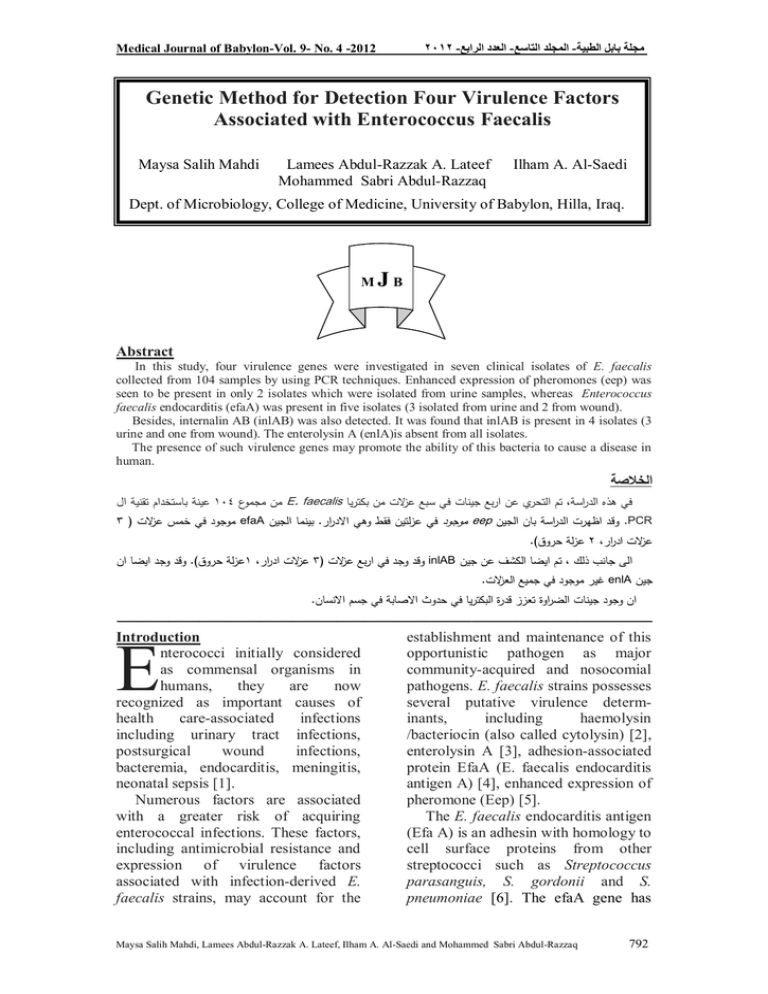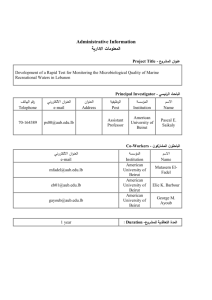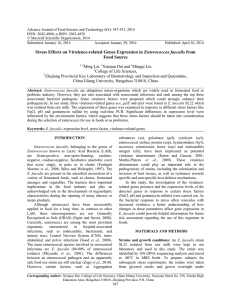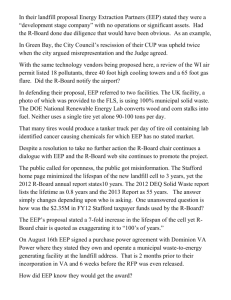Document 12454390
advertisement

2102 - العدد الرابع- المجلد التاسع-مجلة بابل الطبية Medical Journal of Babylon-Vol. 9- No. 4 -2012 Genetic Method for Detection Four Virulence Factors Associated with Enterococcus Faecalis Maysa Salih Mahdi Lamees Abdul-Razzak A. Lateef Mohammed Sabri Abdul-Razzaq Ilham A. Al-Saedi Dept. of Microbiology, College of Medicine, University of Babylon, Hilla, Iraq. M JB Abstract In this study, four virulence genes were investigated in seven clinical isolates of E. faecalis collected from 104 samples by using PCR techniques. Enhanced expression of pheromones (eep) was seen to be present in only 2 isolates which were isolated from urine samples, whereas Enterococcus faecalis endocarditis (efaA) was present in five isolates (3 isolated from urine and 2 from wound). Besides, internalin AB (inlAB) was also detected. It was found that inlAB is present in 4 isolates (3 urine and one from wound). The enterolysin A (enlA)is absent from all isolates. The presence of such virulence genes may promote the ability of this bacteria to cause a disease in human. الخالصة عينة باستخدام تقنية ال404 من مجموعE. faecalis تم التحري عن اربع جينات في سبع عزالت من بكتريا,في هذه الدراسة 3 ( موجود في خمس عزالتefaA بينما الجين. موجود في عزلتين فقط وهي االدرارeep وقد اظهرت الدراسة بان الجين.PCR .) عزلة حروق2 ,عزالت ادرار وقد وجد ايضا ان.)عزلة حروق4 , عزالت ادرار3( وقد وجد في اربع عزالتinlAB تم ايضا الكشف عن جين, الى جانب ذلك . غير موجود في جميع العزالتenlA جين .ان وجود جينات الضراوة تعزز قدرة البكتريا في حدوث االصابة في جسم االنسان ـ ـ ـ ـ ـ ـ ـ ـ ـ ـ ـ ـ ـ ـ ـ ـ ـ ـ ـ ـ ـ ـ ـ ــ ـ ـ ـ ـ ـ ـ ـ ـ ـ ـ ـ ـ ـ ـ ـ ــ ـ ـ ـ ـ ـ ـ ـ ـ ـ ـ ـ ـ ـ ـ ــ ـ ـ ـ ـ ـ ـ ـ ـ ـ ـ ـ ـ ـ ـ ـ ــ ـ ـ ـ ـ ـ ـ ـ ـ ـ ـ ـ ـ ـ ـ ــ ـ ـ ـ ـ ـ ـ ـ ـ ـ ـ ـ ـ ـ ـ ـ ــ ـ ـ ـ ـ ـ ـ ـ ـ ـ ـ ـ ـ ـ ـ ـ ــ ـ ـ ـ ـ ـ ـ ـ ـ ـ ـ ـ ـ ـ ـ ــ ـ ـ ـ ـ ـ ـ ـ ـ ـ ـ ـ ـ ـ ـ ـ ــ ـ ـ ـ ـ ـ ـ ـ ـ ـ ـ ـ ـ ــ ـ ـ ـ ـ ـ ـ ـ ـ ـ ـ ـ ـ ـ ـ ـ ـ ـ ـ ـ ـ ـ ـ ـ ــ ـ ـ ـ ـ ـ ـ ـ ـ ـ ـ ـ ـ ـ ـ ـ ــ ـ ـ ـ ـ ـ ـ ـ ـ ـ ـ ـ ـ ـ ـ ــ ـ ـ ـ ـ ـ ـ ـ ـ ـ ـ ـ ـ ـ ـ ـ ــ ـ ـ ـ ـ ـ ـ ـ ـ ـ ـ ـ ـ ـ ـ ــ ـ ـ ـ ـ ـ ـ ـ ـ ـ ـ ـ ـ ـ ـ ـ ــ ـ ـ ـ ـ ـ ـ ـ ـ ـ ــ Introduction nterococci initially considered as commensal organisms in humans, they are now recognized as important causes of health care-associated infections including urinary tract infections, postsurgical wound infections, bacteremia, endocarditis, meningitis, neonatal sepsis [1]. Numerous factors are associated with a greater risk of acquiring enterococcal infections. These factors, including antimicrobial resistance and expression of virulence factors associated with infection-derived E. faecalis strains, may account for the E establishment and maintenance of this opportunistic pathogen as major community-acquired and nosocomial pathogens. E. faecalis strains possesses several putative virulence determinants, including haemolysin /bacteriocin (also called cytolysin) [2], enterolysin A [3], adhesion-associated protein EfaA (E. faecalis endocarditis antigen A) [4], enhanced expression of pheromone (Eep) [5]. The E. faecalis endocarditis antigen (Efa A) is an adhesin with homology to cell surface proteins from other streptococci such as Streptococcus parasanguis, S. gordonii and S. pneumoniae [6]. The efaA gene has Maysa Salih Mahdi, Lamees Abdul-Razzak A. Lateef, Ilham A. Al-Saedi and Mohammed Sabri Abdul-Razzaq 792 Medical Journal of Babylon-Vol. 9- No. 4 -2012 since been found to be the third gene of the efaCBA operon, likely encoding an ABC-type transporter, with EfaA being the lipoprotein component. The biological role of EfaA and the regulation of its expression are relatively unknown; a potential role of the protein in vivo was demonstrated in a murine model of peritonitis [7]. Enterolysin A is the first bacteriocin from an Enterococcus belonging to class III, the large and heat-labile bacteriocins Enterolysin A production does not occur parallel with growth, a production pattern that has been observed for several lactic acid bacteria (LAB) bacteriocins Since EnlA degrades cell walls of sensitive bacteria and exhibits sequence similarity to these bacteriocins, it is likely that EnlA has a similar mode of action. The sequence analysis of enterolysin A suggested that this bacteriocin consists of two separate domains, an N-terminal catalytic domain and a C-terminal substrate recognition domain. EnlA exhibits identity with cell wall-degrading enzymes produced by different grampositive bacteria [8]. Enhanced expression of pheromone (Eep) is a predicate metallopeptidase and has been shown to cleave the signal peptides of lipoproteins to yield octapeptides that act as bacterial pheromones, inducing conjugation between different strains of E. faecalis. Eep itself does not contain the pheromone sequence but was necessary for pheromone expression [9]. On the other hand, inlAB encoded by two genes (inlA and inlB) organized in an operon, are considered to play a major role in Listeria internalization into cultured cells [10]. InlA and InlB have common structural features also shared by other proteins constituting the internalin multigene family, i.e., 2102 - العدد الرابع- المجلد التاسع-مجلة بابل الطبية two repeat regions, the leucine-rich repeat (LRR) region and the B-repeat region, separated by a highly conserved inter-repeat (IR) region. Moreover, a functional analysis of internalin demonstrates that its aminoterminal region, encompassing the leucine-rich repeat (LRR) region and the inter-repeat (IR) region, is necessary and sufficient to promote bacterial entry into cells expressing its receptor [11]. Lecuit, M et al [12] were demonstrated that internalin confers invasiveness to Enterococcus faecalis. The purpose of the present study was to assess the occurrence of this virulence factors in Enterococcus faecalis strains isolates from different clinical specimens. Materials and Methods Patients: A total 104 samples, only seven isolates of Enterococcus faecalis were obtained from patients with burn wound and urinary tract infection by standard bacteriological methods. All samples were obtained from patients or individuals who admitted to Al-Hilla Surgical Teaching Hospital in Babylon Governorate. Bacterial identification: The samples were processed on blood agar and selective media( crystal violet and sodium aziad) were incubated at 37cₒ overnight. The identification of gram positive bacteria was performed by standard biochemical methods (catalase test, oxidase test, tolerance to bile-aesculin, growth in 6.5% NaCl, hemolysin, and growth at 10-45cₒ) according to Bergy’s Manual for Determinative Bacteriology [13]. DNA extraction for gram positive bacteria: DNA extraction was carried out according to the genomic DNA purification kit supplemented by Maysa Salih Mahdi, Lamees Abdul-Razzak A. Lateef, Ilham A. Al-Saedi and Mohammed Sabri Abdul-Razzaq 793 Medical Journal of Babylon-Vol. 9- No. 4 -2012 manufactured company (promega, USA) (cat# A 1120). Detection of some virulence gene markers by PCR: The primers and PCR conditions used to amplify genes encoding virulence factors with PCR are listed in table (1). The primers includes eep gene, efaA and enlA, as well as the primer specific for the int. Each 25µl of PCR reaction contained 2.5µl of 2102 - العدد الرابع- المجلد التاسع-مجلة بابل الطبية each upstream and downstream primer, 2.5µl of free nuclease water, 5µl of DNA extraction and 12.5µl of master mix. The PCR amplification product were visualized by electrophoresis on 1% agarose gels for 45min at 70v. The size of the amplicons were determined by comparison to the 100 bp allelic ladder (promega, USA) (cat# G 2101). Table 1 Primers sequences and PCR condition using to detect virulence gene Genes Primer sequence (5ʹ-3ʹ) Eep F Eep R GAGCGGGTATTTTAGTTCGT TACTCCAGCATTGGATGCT Size of product bp PCR condition 94ºC 937 5min Reference 1x 90ºC 45sec 58ºC 1min 30x 72ºC 1min 14 72ºC 3min 1x efaA F efaA R GACAGACCCTCACGAATA AGTTCATCATGCTGCTGTAGTA 705 94ºC 5min 1x 94ºC 52ºC 72ºC 45sec 1min 30x 1min 15 72ºC 3min 1x 94ºC 5min enlA F enlA R TTCTTCTTATTCTGTCAACGCAGC GACTGTGAAATACCTATTTGCAAGC 960 InlAB F InlAB R CTACACCACCTTCCGCAAAT AAAATTCCACTCATGCCCAC 350 94ºC 59ºC 72ºC 72ºC 45sec 1min 30x 1min 3min 1x 94ºC 2min 94ºC 57ºC 72ºC 72ºC 1x 14 1x 30sec 30sec 40x 1min 7min 1x 16 Company of primers is alpha (USA). Results Four primers were used to investigate the presence of four important genes these are eep, efaA, enlA and inlAB genes for 7 E. faecalis isolated from different clinical samples. It was found that eep is present only in 2 isolates, includes urine and were positive after amplification was shown in figure (1). Maysa Salih Mahdi, Lamees Abdul-Razzak A. Lateef, Ilham A. Al-Saedi and Mohammed Sabri Abdul-Razzaq 794 2102 - العدد الرابع- المجلد التاسع-مجلة بابل الطبية Medical Journal of Babylon-Vol. 9- No. 4 -2012 L 2 3 4 5 6 7 8 Figure 1Gel electrophoresis of PCR of eep amplicon product. L: ladder; 2, 3, 4, 5,6: no. of isolates obtained from urine; 7, 8: no. of isolates obtained from wound enlA is absent from all isolates. On the other hand efaA is present in 5 isolates includes urine (3 samples), L 2 3 4 wound (2 samples), were positive after amplification was shown in figure (2). 5 6 7 8 Figure 2 Gel electrophoresis of PCR of efaA amplicon product. L: ladder; 2, 3, 4, 5,6: no. of isolates obtained from urine; 7, 8: no. of isolates obtained from wound InlAB is present in 4 isolates includes urine (3 samples), wound (1 sample), were positive after amplification was shown in figure (3). Maysa Salih Mahdi, Lamees Abdul-Razzak A. Lateef, Ilham A. Al-Saedi and Mohammed Sabri Abdul-Razzaq 795 2102 - العدد الرابع- المجلد التاسع-مجلة بابل الطبية Medical Journal of Babylon-Vol. 9- No. 4 -2012 L 2 3 4 5 6 7 8 Figure 3 Gel electrophoresis of PCR of inlAB amplicon product. L: ladder; 2, 3, 4, 5,6: no. of isolates obtained from urine; 7, 8: no. of isolates obtained from wound Discussion The virulence of enterococci is due to their adherence and lytic activity [17], as in other bacteria, many factors of enterococci are known but the most frequently mentioned and detected in this study by using PCR with primers specific genes includes: eep, efaA, enlA, and inlAB. It was found that Eep is present in only two isolates (28.5%). This results was identical with [18] was detected eep in (31.5%) of isolates which was lower than the 58.9, and 73% prevalence of eep detected in E. faecalis isolates from Brazil [14], and Sweden [19], respectively. The low prevalence of the virulence-associated genes in this study could be due to the clinical conditions of the patients. Local study conducted in Baghdad on E. faecalis indicat that most E. faecalis can produce pheromone extracellulary at various levels [20]. The production of normal levels of pheromones requires the presence of an intramembrane protein, the enhanced expression of pheromone (Eep) encoded by eep [9]. Eep is involved in the processing of pheromone precursor, the regulation of its expression or secretion. Enterococcal eep mutants did not produce detectable pheromone. It was therefore suggested that it might be involved in processing of pheromone precursors [21]. Besides enlA was absent from all isolates. [14] was found that this virulence determinant was found at a low rate (9.5%) among clinical strains, with a tendency for it to be present more often among urinary strains than in purulent exudates and rectal swab strains. efaA is present in five isolates (71.4%). This results is agreement with [14] show that more than half of the clinical strains harboured efaA gene markers. It was found that the production of EfaA by strains of E. faecalis is common. On the other hand, [15] and [22] had found that the efaA gene in all the clinical E. faecalis strains (blood, pus, urine, feces). inlAB is present in four isolates (57.4%), this may indicate that there is sequence homology of this gene in L. monocytogenes with that in E. faecalis. [12] was demonstrate that the internalin heterologous expression in E. faecalis also conferred invasiveness. E. faecalis cells expressing internalin became invasive reinforced the hypothesis that internalin was Maysa Salih Mahdi, Lamees Abdul-Razzak A. Lateef, Ilham A. Al-Saedi and Mohammed Sabri Abdul-Razzaq 796 Medical Journal of Babylon-Vol. 9- No. 4 -2012 sufficient for stimulation the disease. However, the fact that S. epidermidis cells expressing internalin remained noninvasive reactivated the possibility that a cofactor present in L. monocytogenes, L. innocua, and E. faecalis but absent in S. epidermidis which is more distantly related to the genus Listeria than is E. faecalis was required for internalin-mediated entry[23]. These results indicate that each steps in the infection process can be mediated by a number of alternative virulence factors and each strain may have a unique combination of these factors. The absence of virulence genes in some of the isolates suggests that infections by E. faecalis may require the involvement of multiple virulence factors. The pathogenic role of several virulence factors identified in E. faecalis is still questionable and the meaning of these determinants in strains recovered from clinical strains is uncertain [14]. References 1-Moellering MC. (1992). Emergence of Enterococcus as a significant pathogen. Clin Infect Dis 14:1173-6. 2-Ike, Y., Clewell, D. B., Segarra, R. A. & Gilmore, M. S. (1990). Genetic analysis of the pAD1 hemolysin/bacteriocin determinant in Enterococcus faecalis: Tn917 insertional mutagenesis and cloning. J Bacteriol 172, 155–163. 3- Nilsen, T., Nes, I. F. & Holo, H. (2003). Enterolysin A, a cell walldegrading bacteriocin from Enterococcus faecalis LMG 2333. Appl Environ Microbiol 69, 2975– 2984. 4-Lowe, A. M., Lambert, P. A. & Smith, A. W. (1995). Cloning of an Enterococcus faecalis endocarditis antigen: homology with adhesins from 2102 - العدد الرابع- المجلد التاسع-مجلة بابل الطبية some oral streptococci. Infect Immun 63, 703–706. 5- An, F. Y., Sulavik, M. C. & Clewell, D. B. (1999). Identification and characterization of a determinant (eep) on the Enterococcus faecalis chromosome that is involved in production of the peptide sex pheromone cAD1. J Bacteriol 181, 5915–5921. 6Güven, K. and Dag Ø. (2004).virulence factors of Enterococcus faecalis: relationship to endodontic disease. Crit Rev Oral Biol Med 15(5):308-320 7- Yuen L. Low, Nicholas S. Jakubovics, Jennifer C. Flatman, Howard F. Jenkinson and Anthony W. Smith. (2003). Manganese-dependent regulation of the endocarditisassociated virulence factor EfaA of Enterococcus faecalis. Journal of Medical Microbiology , 52, 113–119. 8- Trine Nilsen, Ingolf F. Nes, and Helge Holo. (2003). Enterolysin A, a Cell Wall-Degrading Bacteriocin from Enterococcus faecalis LMG 2333. Applied and environmental microbiology, p. 2975–2984 Vol. 69, No. 5 9- Florence Y. An and Don B. Clewell. (2002). Identification of the cAD1 Sex Pheromone Precursor in Enterococcus faecalis. J. Bacteriol. 184(7):18801887. 10- Dramsi, S., I. Biswas, E. Maguin, L. Braun, P. Mastroeni, and P. Cossart.. (1995). Entry of L. monocytogenes into hepatocytes requires expression of InlB, a surface protein of the internalin multigene family. Mol. Microbiol. 16:251–261. 11. Dramsi, S., P. Dehoux, M. Lebrun, P. L. Goossens, and P. Cossart. (1997). Identification of four new members of the internalin multigene family in Listeria monocytogenes EGD. Infect. Immun. 65:1615–1625 12- Lecuit, M., Ohayon, H., Braun, L., Mengaud, J., Cossart, P . (1997). Maysa Salih Mahdi, Lamees Abdul-Razzak A. Lateef, Ilham A. Al-Saedi and Mohammed Sabri Abdul-Razzaq 797 Medical Journal of Babylon-Vol. 9- No. 4 -2012 Internalin of Listeria monocytogenes with an intact leucine-rich repeat region is sufficient to promote internalization. Infect. Immun. Vol. 65, No. 12 p. 5309–5319 13- Holt JC, Krieg NR, Sneath A, Stachley JT, William ST (1994). Bergy,s manual of determinative bacteriology, 9thed. USA, pp.552. 14- Elisa Bittencourt de Marques and Se´ rgio Suzart. (2004). Occurrence of virulence-associated genes in clinical Enterococcus faecalis strains isolated in Londrina, Brazil.. Journal of Medical Microbiology, 53, 1069–1073. 15- Eaton, T. J. & Gasson, M. J. (2001). Molecular screening of Enterococcus virulence determinants and potential for genetic exchange between food and medical isolates. Appl Environ Microbiol 67, 1628– 1635. 16- Bubert, A., Sokolovic, Z., Chun, S.K.; Papatheodorou, L., Simm, A. and Goebel, W. (1999). Differential expression of Listeria monocytogenes virulence genes in mammalian host cell. Mol. Gen. Genet. 261:323-336. 17- Jankoska, G., Trajkovska-Dokic, E., Panovski, N., Popovska-Jovanovsk, K. and Petrovask, M. (2008). Virulence factors in Enterococccus faecalis isolated from urine samples. J. Biol. Med. Sci. MASA. P:56-66. 18- Edet E. Udo and Al-Sweih, N. (2011). Frequency of VirulenceAssociated Genes in Enterococccus faecalis Isolated in Kuwait Hospitals. Med Princ Pract .20:259–264. 19- Hallgren A, Claesson C, Saeedi B, Monstein H-J, Hanberger H, Nilsson LE. (2009): Molecular detection of aggregation substance, Enterococcus surface protein, and cytolysin genes in vitro adhesion to urinary catheters of Enterococcus faecalis and E. faecium of clinical origin. Int J Med Microbiol; 299: 323– 332. 20- Al-Khafaji, J. K. T. (2006). Bacteriological and genetic study on 2102 - العدد الرابع- المجلد التاسع-مجلة بابل الطبية some isolates of Enterococcus faecalis from different clinical and environmental sources at Babylon province. Ph. D. thesis. College of Science. Al-Mustanseria University. 21- Florence Y. An, Mark C. Sulavik and Don B. Clewell. (1999). Identification and Characterization of a Determinant (eep) on the Enterococcus faecalis Chromosome That Is Involved in Production of the Peptide Sex Pheromone cAD1. J. Bacteriol. 181(19):5915. 22- Creti, R., Imperi, M., Bertuccini, L., Fabretti, F., Orefici, G., Di Rosa, R. & Baldassarri, L. (2004). Survey for virulence determinants among Enterococcus faecalis isolated from different sources. J Med Microbiol 53, 13–20. 23- Devriese, L. A., M. D. Collins, and R. Wirth. 1992. The genus Enterococcus, p. 1465–1481. In A. Balows (ed.), The prokaryotes. Springer-Verlag, New York, N.Y. Maysa Salih Mahdi, Lamees Abdul-Razzak A. Lateef, Ilham A. Al-Saedi and Mohammed Sabri Abdul-Razzaq 798

![medicine3_33[^]](http://s3.studylib.net/store/data/007298585_1-a62be5f279aa0f8ef6282c4c51ca07b8-300x300.png)





